Virginia State Capitol | |
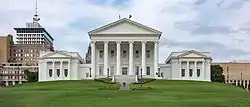 The Virginia State Capitol Building in Richmond in August 2017 | |
| Location | 1000 Bank St, Richmond, Virginia, U.S. |
|---|---|
| Built | 1785–1788 |
| Architect | Thomas Jefferson; Charles-Louis Clérisseau |
| Architectural style | Early Republic, Palladian |
| NRHP reference No. | 66000911[1] |
| VLR No. | 127-0002 |
| Significant dates | |
| Added to NRHP | October 15, 1966 |
| Designated NHL | December 19, 1960[2] |
| Designated VLR | November 5, 1968[3] |
The Virginia State Capitol is the seat of state government of the Commonwealth of Virginia, located in Richmond, the state capital. It houses the oldest elected legislative body in North America, the Virginia General Assembly, first established as the House of Burgesses in 1619.
The Capitol was conceived of by Thomas Jefferson and Charles-Louis Clérisseau in France, based on the Maison Carrée in Nîmes. Construction began in 1785 and was completed in 1788. The current Capitol is the eighth built to serve as Virginia's statehouse, primarily due to fires during the Colonial period. The building also served as the Confederate States Capitol during the Civil War from 1861 to 1865. In the early 20th century, two wings were added, leading to its present appearance. In 1960, it was designated a National Historic Landmark.
History
Colonial precursors in Jamestown and Williamsburg
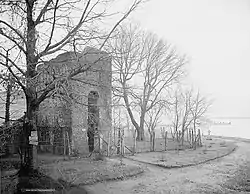
.jpg.webp)
During the American colonial era, the Colony of Virginia's first capital was Jamestown, where the first legislative body, the Virginia House of Burgesses, met in 1619. The new government used four state houses at different times at Jamestown due to fires. The first Representative Legislative Assembly convened on July 30, 1619 at the Jamestown Church which served as the first Capitol.[4]
With the decision to relocate the government inland to Williamsburg in 1699, a grand new Capitol building was completed in November 1705. Nearby was the grand Governor's Palace. It burned in 1747 and was replaced in 1753. On June 29, 1776, Virginians declared their independence from Great Britain and wrote the state's first constitution, thereby creating an independent government four days before Congress voted for the Declaration of Independence in Philadelphia on July 4.
The Capitol at Williamsburg served until the American Revolutionary War began, when Governor Thomas Jefferson urged that the capital be relocated to Richmond. The building was last used as a capitol on December 24, 1779, when the Virginia General Assembly adjourned to reconvene in 1780 at the new capital, Richmond. It was eventually destroyed.
Richmond and state capitol design
_in_1858.jpg.webp)
When it convened in Richmond on May 1, 1780, the legislature met in a makeshift building near Shockoe Bottom. By 1788, the "Old Capitol" where the Virginia Ratifying Convention met was at the New Academy by the Chevalier Quesnay.
Plans were begun for a new building to serve a new state, the Commonwealth of Virginia. The site selected for a new, permanent building was on Shockoe Hill, a major hill overlooking the falls of the James River.
.jpg.webp)
Thomas Jefferson is credited with the overall design of the new Capitol, together with French architect Charles-Louis Clérisseau. The design was modeled after the Maison Carrée at Nîmes in southern France, an ancient Roman temple.[6] The only other state to accurately copy an ancient model is the Vermont State House, which based its portico on the Temple of Hephaestus in Athens. Jefferson had Clérisseau substitute the Ionic order over the more ornate Corinthian column designs of the prototype in France. At the suggestion of Clérisseau, it used a variant of the Ionic order designed by Italian student of Andrea Palladio, Vincenzo Scamozzi.[7]
The cornerstone was laid on August 18, 1785, with Governor Patrick Henry in attendance, prior to the completion of its design. In 1786, a set of architectural drawings and a plaster model were sent from France to Virginia, where it was executed by Samuel Dobie. It was sufficiently completed for the General Assembly to meet there in October 1792.
It is one of only twelve Capitols in the United States without an external dome. (The others are the Capitols of Alaska, Delaware, Florida, Hawaii, Louisiana, New Mexico, New York, North Dakota, Ohio, Oregon and Tennessee.)[8]
American Civil War
The building also served as the Capitol of the Confederacy during the American Civil War (1861–65) (It was the Confederacy's second home, the first being the Alabama State Capitol in Montgomery, Alabama).
The Capitol, the adjacent Virginia Governor's Mansion, and the White House of the Confederacy (about three blocks to the north on East Clay Street) were spared when departing Confederate troops were ordered to burn the city's warehouses and factories, and fires spread out of control in April 1865. John Brown's carpet-bag, full of documents including many unpublished ones, was kept in the Virginia Capitol from 1860 to 1865 by Andrew Hunter, at that time a state senator. When Richmond fell, "so Yankees can't find them", the carpet-bag was hidden "between the wall and the plastering". It has never been found.[9]
The first Flag of the United States to fly over the capitol since secession was hoisted by Lieutenant Johnston L. de Peyster. U.S. President Abraham Lincoln toured the Capitol during his visit to Richmond about a week before his assassination in Washington, DC.
From April 6 until April 10, 1865 Lynchburg served as the Capital of Virginia. Under Gov. William Smith, the executive and legislative branches of the commonwealth moved to Lynchburg for the few days between the fall of Richmond and the fall of the Confederacy.
On July 24, 2020, House Speaker Eileen Filler-Corn ordered the removal of a statue of Confederate General Robert E. Lee, along with busts of J.E.B. Stuart, Stonewall Jackson, Jefferson Davis, and other Confederates from the historic Old House Chamber.[10][11]
1870 Tragedy
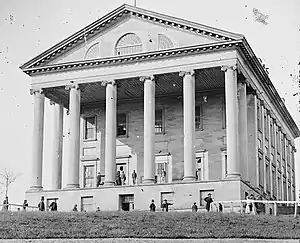
After the end of the American Civil War, during the Reconstruction period, Virginia was under military rule for almost five years, ending in January 1870. In the ensuing months, a dispute over leadership of the Richmond government resulted in the Virginia Supreme Court of Appeals holding a hearing on April 27, 1870, in the large courtroom on the second floor of the Capitol. Several hundred people crowded in. Before the proceedings could begin, the gallery gave way and fell to the courtroom floor. This added weight, in addition to the crowd already there, caused the entire courtroom floor to give way, falling 40 feet (12 m) into the House of Delegates chamber.
The injured stumbled, crawled or were carried out onto the Capitol lawn during the mayhem that followed. Sixty-two people were killed and 251 injured.[12] There were no women believed to have been present when the collapse occurred. The dead included a grandson of Patrick Henry, and three members of the General Assembly. Injured included both men contesting the Richmond mayoral position, the speaker of the House of Delegates, a judge and ex-governor Henry H. Wells. Former Confederate general Montgomery D. Corse was partially blinded by the collapse.
Rebuilding, expansion, renovation

Despite demands for the building's demolition, the damage from the tragedy of 1870 was repaired. In 1904, two wings (not in the original plans) were added to the east and west ends of the building to provide much-needed additional space for the growing legislature. These additions were built to the collaborative designs of three of Virginia's leading architects and architectural firms: Frye & Chesterman of Lynchburg, John Kevan Peebles of Norfolk and Noland & Baskervill of Richmond.[13]
In 2003, the assembly approved $83.1 million for the renovation, restoration and expansion of the Capitol. Work began in 2004 and was completed on May 1, 2007. Among major changes are a completely new HVAC control system, updated mechanical, storm water and plumbing systems, and construction of a 27,000-square-foot (2,500 m2) expansion beneath the hill on the south lawn. The expansion provides a visitor's entrance that is compliant with the Americans with Disabilities Act, plus office space and meeting rooms, and better security management. The final cost of the restoration was approximately $104 million. The extension was designed by architect Sonja Bijelić of RMJM.[14]
The Virginia National Guard was activated to provide extra security at the Virginia State Capitol, prior to the 2021 Inauguration of Joe Biden, in response to the FBI warning of possible armed protests at US capitals.[15]
Individuals known to have lain in state/repose
- June 1806: George Wythe, Signer of the Declaration of Independence from Virginia
- January 21, 1862: John Tyler, Tenth President of the United States; 23rd Governor of Virginia
- May 15, 1863: Thomas J. "Stonewall" Jackson, Confederate general
- June 15, 1971: J. Sargeant Reynolds, then-Lieutenant Governor of Virginia
- September 30, 1991: A. L. Philpott, then-Speaker of the Virginia House of Delegates
- February 11, 2011: Leroy R. Hassell Sr., then-Chief Justice of the Virginia Supreme Court (first African American in Virginia to be afforded the honor)
- January 29–30, 2013 Harry L. Carrico, Former Chief Justice with over 42 years of service as an active Justice on the Virginia Supreme Court
- September 6, 2017: Lacey Putney, Former House Speaker and longest serving legislator in Virginian history (1962–2014)
Interior
 Rotunda, with Jean-Antoine Houdon's statue of George Washington in the center
Rotunda, with Jean-Antoine Houdon's statue of George Washington in the center Roof of the rotunda
Roof of the rotunda Old House of Delegates Chamber
Old House of Delegates Chamber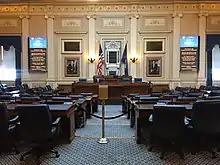 (New) House of Delegates Chamber
(New) House of Delegates Chamber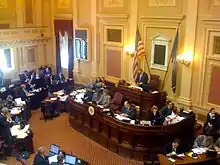 Senate Chamber (in session)
Senate Chamber (in session)
Capitol Square
Bell Tower | |
| Location | Capitol Sq., Richmond, Virginia |
|---|---|
| Area | 14.1 acres (5.7 ha) |
| Built | 1824 |
| Architect | Swain, Levi |
| Architectural style | Federal |
| NRHP reference No. | 69000347[1] |
| VLR No. | 127-0121 |
| Significant dates | |
| Added to NRHP | June 11, 1969 |
| Designated VLR | November 5, 1968[3] |
The area around the Capitol is known as Capitol Square. It contains several monuments to prominent Virginians and events in Virginia:
- Washington Monument, 1858
- In 1869, the monument was completed, with statues of the following encircling the base:
- General Thomas J. "Stonewall" Jackson Statue, 1875
- Governor William "Extra Billy" Smith Statue, 1906
- Dr. Hunter Holmes McGuire Statue, 1904
- Zero Milestone, 1929, for measuring highway distances from the city of Richmond
- Edgar Allan Poe Statue, 1958
- Harry F. Byrd Sr. Statue, 1976
- Virginia Civil Rights Memorial, 2008
- The Bell Tower was built in 1824–1825. It is still used for ceremonial ringing.
- Oliver Hill Building (1892-1894)
In film and television
Given its Classical Revival style of architecture along with the fact that its color is white, the Capitol was the double for the exterior shots of The White House featured in the movie The Contender (2000) starring Gary Oldman, Joan Allen, Jeff Bridges, Christian Slater.[16]
In the 1993 comedy-drama film Dave with Kevin Kline, Sigourney Weaver, Frank Langella; the House of Delegates chamber served as the set for the United States House of Representatives, where the title character President addresses a joint session of Congress.
In the 2012 film Lincoln, the Virginia State Capitol was used as a stand-in for the United States Capitol in Washington D.C. during the Civil War era with some film retouching.
See also
References
- 1 2 "National Register Information System". National Register of Historic Places. National Park Service. March 15, 2006.
- ↑ "Confederate Capitol". National Historic Landmark summary listing. National Park Service. Archived from the original on December 27, 2007. Retrieved June 23, 2008.
- 1 2 "Virginia Landmarks Register". Virginia Department of Historic Resources. Archived from the original on 21 September 2013. Retrieved 19 March 2013.
- ↑ "Jamestown Churches". National Park Service. Retrieved February 2, 2014.
- ↑ Grigsby, Hugh Blair. The History of the Virginia Federal Convention: 1788. Da Capo Press, New York 1969 p.67. Initially built as the New Academy built by the Chevalier Quesnay, subsequently the Richmond Theater
- ↑ Roth, Leland M. (1993). Understanding Architecture: Its Elements, History and Meaning (First ed.). Boulder, CO: Westview Press. p. 414. ISBN 0-06-430158-3.
- ↑ Brownell, Charles E. (1992). The Making of Virginia Architecture. Virginia Museum of Fine Arts. pp. 46–53, 214–217.
- ↑ "Domes, Domes, Domes". National Conference of State Legislators. January 21, 2020. Retrieved March 22, 2020.
- ↑ Hunter, Andrew (April 8, 1888). "John Brown's Carppet-bag". St. Louis Globe-Democrat (St. Louis, Missouri). p. 27 – via newspapers.com.
- ↑ Schneider, Gregory S. (July 24, 2020). "Confederate memorials quietly removed from Virginia Capitol overnight". Washington Post. Retrieved December 22, 2020.
- ↑ "Virginia evicts Confederate monuments from its state Capitol". AP NEWS. July 24, 2020. Retrieved December 22, 2020.
- ↑ Christian, George L. (1915). The Capitol disaster. A chapter of reconstruction in Virginia. Richmond, Virginia: Richmond Press, Inc.
- ↑ Engineering News 9 June 1904: 447. New York.
- ↑ ArchSTUDIO2227: The Virginia Capitol Extension
- ↑ "U.S. capitals on edge for armed protests as Trump presidency nears end". Yahoo. January 16, 2021. Retrieved January 16, 2021.
- ↑ ""The Contender" – filmed on location in Virginia and starring Gary Oldman, Joan Allen and Jeff Bridges – opens October 13" (PDF) (Press release). Virginia Film Office. September 28, 2000. Retrieved January 30, 2013.
External links
- Official website
- Visiting Information from the Virginia General Assembly Archived May 11, 2008, at the Wayback Machine
- State Library of Virginia – Virginia State Capitol online exhibit Archived 2005-03-21 at the Wayback Machine
- "A Brief History of the Public Privy on Capitol Square" at Virginia Memory
- Virginia State Capitol, Bank and 10th Streets, Capitol Square, Richmond, Independent City, VA: 155 photos, 12 color transparencies, 48 measured drawings, 88 data pages, and 12 photo caption pages at Historic American Buildings Survey
- The Bell Tower, Capitol Square, Richmond, Independent City, VA: 2 photos, 2 measured drawings, and 6 data pages at Historic American Buildings Survey


